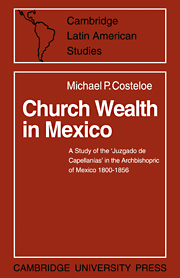 Church Wealth in Mexico
Church Wealth in Mexico Book contents
- Frontmatter
- Contents
- Acknowledgements
- Preface
- Abbreviations
- Introduction
- 1 The Juzgado de Capellanías. Organization and employees
- 2 The Juzgado and its revenue
- 3 Personal loans from the Juzgado
- 4 The effects of clerical investment
- 5 The Juzgado and the State
- Conclusion
- List of sources and works cited
- Index
2 - The Juzgado and its revenue
Published online by Cambridge University Press: 27 March 2010
- Frontmatter
- Contents
- Acknowledgements
- Preface
- Abbreviations
- Introduction
- 1 The Juzgado de Capellanías. Organization and employees
- 2 The Juzgado and its revenue
- 3 Personal loans from the Juzgado
- 4 The effects of clerical investment
- 5 The Juzgado and the State
- Conclusion
- List of sources and works cited
- Index
Summary
The activities and business undertaken and conducted by the employees described in the previous chapter involved and were dependent upon the revenue of the Juzgado, which resulted mainly from the three sources mentioned in the title of the institution, namely wills, capellanías, and pious works. To some extent these three sources overlap, for benefices and pious works were usually established by will. Indeed, income from legacies was throughout the colonial period a most important branch of ecclesiastical finance and bequests of enormous amounts were made. It seems probable that almost every person who was financially able to do so did leave some form of legacy to a clerical corporation. The administration of the majority of these donations was entrusted to the Juzgado.
The most common form of bequests were the capellanía and the pious work. The latter requires little comment. Many people left funds or property, the income from which was to be devoted to a pious work. For example, in the year 1796 Juan Acosta left 200,000 pesos to the Church and this sum was to be invested to yield an annual income of 8,000 pesos. Half of the income was to be devoted each year to the establishment of a capellanía, and the other half was to be used for the dowry of a novice wishing to take the final vows. Most of the charitable institutions managed by the clergy were supported by monetary gifts and legacies, and money was often left towards the maintenance of an orphanage or hospital.
- Type
- Chapter
- Information
- Church Wealth in MexicoA Study of the 'Juzgado de Capellanias' in the Archbishopric of Mexico 1800–1856, pp. 46 - 65Publisher: Cambridge University PressPrint publication year: 1967
